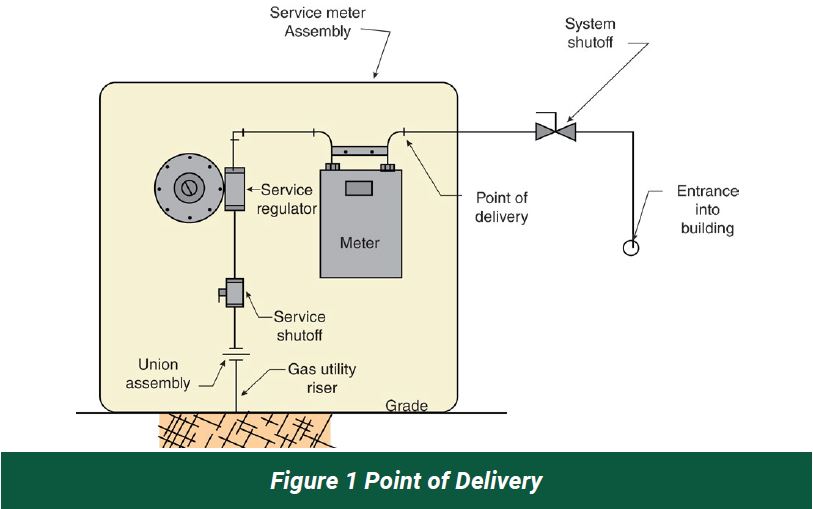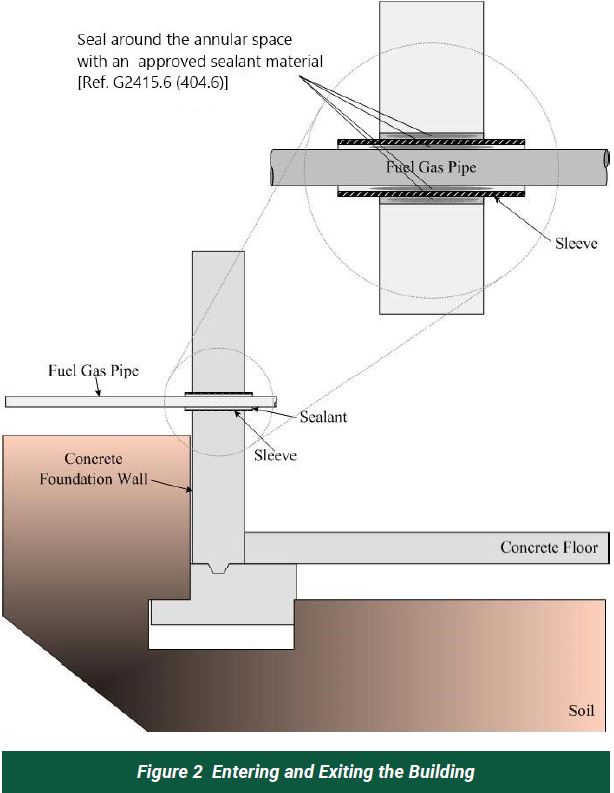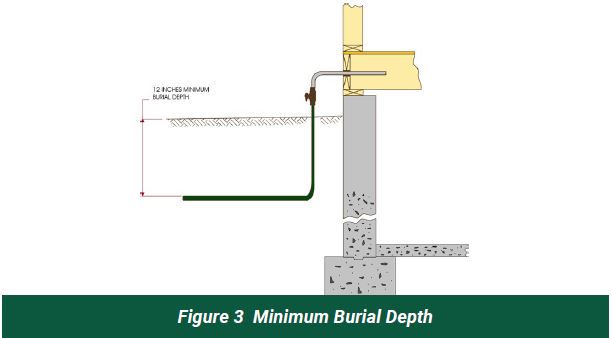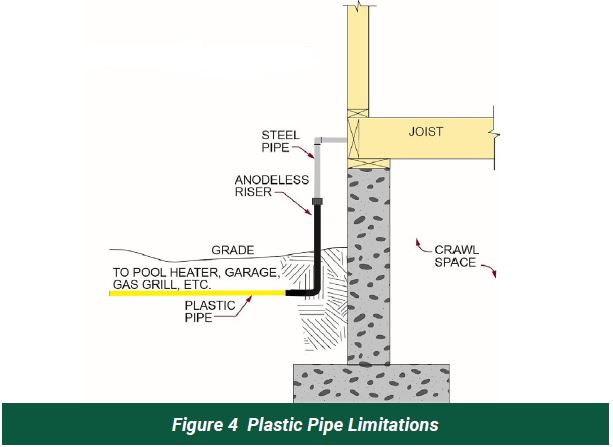
CodeNotes: Underground Gas Piping System Requirements in the I-Codes
Fuel gas plays an integral role in day-to-day life in the United States. This CodeNotes will review some of the major code requirements that are found in the 2021 IRC and IFGC for underground fuel gas piping.
This edition of CodeNotes — Underground Gas Piping System Requirements in the I-Codes — is based on the 2021 International Residential Code® and the 2021 International Fuel Gas Code®
Introduction
Fuel gas plays an integral role in day-to-day life in the United States. Its use as fuel for various types of appliances is very common in buildings everywhere. Fuel gas piping and appliance installation and venting are covered in the International Fuel Gas Code (IFGC®), and for those buildings under the scope of the International Residential Code (IRC®), it is addressed in the (IRC®) Chapter 24, “Fuel Gas.” This CodeNote® uses a dual numbering system. The section numbers that appear in parentheses after each (IRC®) section number are the section numbers of the corresponding text in the (IFGC®).
This CodeNote® will review some of the major code requirements that are found in the 2021 IRC® and the 2021 IFGC® for underground fuel gas piping. The conditions encountered are quite different from those found in aboveground piping installations. It is also important to note that the (IRC®) and (IFGC®) govern the piping system from the point of delivery (POD), downstream of the meter for a natural gas system, or the second stage regulator for a propane system. The piping upstream of the point of delivery is generally governed by the Department of Transportation (DOT) regulations for natural Gas utilities or the National Fire Protection Association (NFPA) 58-17 for liquefied petroleum gas.
Point of Delivery
A new definition added to the (IRC®) and (IFGC®) clarifies terms that are used in the definition of “point of delivery” and a change to the definition of “service shutoff” coordinates with all the relative definitions. The definition now reads: For natural gas systems, the point of delivery is the outlet of the service meter assembly or the outlet of the service regulator or service shutoff valve where a meter is not provided. Where a system shutoff valve is provided after the outlet of the service meter assembly, such valve shall be considered downstream of the point of delivery. For undiluted liquefied petroleum gas systems, the point of delivery shall be the outlet of the service pressure regulator, exclusive of line gas regulators, in the system.

Liquefied Petroleum Gas Storage
The storage system for liquefied petroleum gas shall be designed and installed in accordance with the International Fire Code and NFPA 58 [Ref. G2412.2 (401.2)].
Underground Penetrations Prohibited
Entering and exiting the building: The (IRC®) and (IFGC®) prohibit gas piping from penetrating the building foundation wall at any point below grade and require that the annular space between the above-ground pipe and the wall be sealed. Where a non-metallic sleeve is installed to protect the gas piping from corrosion and abrasion caused by contact with the foundation wall, the annular spaces between the pipe and the sleeve, and between the sleeve and the wall, must be sealed with an approved sealant material. [Ref. G2415.6 (404.6)].

Underground Piping Protection Methods
The (IRC®) and (IFGC®) do not recognize zinc coatings (galvanizing) as adequate protection for steel gas piping below grade. Metallic piping installed underground is more prone to corrosion than the same piping installed above ground, although corrosion can occur in both environments. Corrosion below grade can be caused by the moisture in the soil acting as an electrolyte to promote galvanic corrosion between two dissimilar metals or by contact with soils that are inherently corrosive to metals. [Ref. G2415.11.1 (404.11.1)].
The (IRC®) and (IFGC®) require underground piping to comply with one or more of the following:
- The piping shall be made of corrosion-resistant material suitable for the environment in which it is installed.
- Pipe shall have a factory-applied, electrically insulating coating. Fittings and joints between sections of coated pipe shall be in accordance with the coating manufacturer’s instructions.
- The piping shall have a cathodic protection system and the system must be monitored and maintained in accordance with an approved program [Ref. G2415.11.2 (404.11.2)].
Polyethylene plastic piping is commonly used to convey fuel gas below grade because it is resistant to corrosion. However, using plastic pipe does not exempt the installer from having to provide corrosion protection. Though plastic piping is a good choice for mitigating corrosion below grade, it is prohibited above grade where it must be protected from mechanical damage. Polyethylene pipe utilizes metallic risers to transition from below grade to above grade, and those risers are susceptible to corrosion. The steel risers connected to plastic piping must be cathodically protected by means of a welded anode except where such risers are anodeless risers [Ref. G2415.11.4 (404.11.4)].
Burial Depth
The code requires a minimum burial depth of 12 inches for underground piping systems. There is an exception that permits supply lines for individual outdoor appliances to be installed a minimum of 8 inches below grade. Such installations must be approved by the Code Official and in locations not susceptible to physical damage. Consideration must be made for expected imposed static loads (such as beneath walls) or in locations (such as driveways) where there may be live loads like vehicular traffic. [Ref. G2415.12 (404.12), G2415.12.1 (404.12.1)]

Plastic Pipe Limitations
Because of the potential hazard associated with the use of materials that have a lower resistance to physical damage and heat as compared to metallic pipe, the installation of plastic pipe cannot be used within or under any building slab or be operated at pressures greater than 100 psig (689 kPa) for natural gas or 30 psig (207 kPa) for LP-gas.

Exceptions
- Plastic pipe can terminate above ground outside of buildings where installed in premanufactured anodeless risers or service head adapter risers that are installed in accordance with the manufacturer’s instructions.
- Plastic pipe can terminate with a wall head adapter within buildings where the plastic pipe is inserted in a piping material for fuel gas use in buildings.
- Plastic piping is allowed under outdoor patios, walkways, and driveway slabs provided that the burial depth complies with Section G2415.12 of the IRC or Section 404.12 in the IFGC [Ref. G2415.17.1 (404.17.1)].
Tracer wire installation
To avoid piping damage and a hazardous condition, the location of the underground piping must be known before excavation work in the vicinity of such piping. The I-Codes require that a yellow-insulated copper tracer wire or other approved conductor, or a product specifically designed for that purpose, be installed adjacent to underground non-metallic piping. Access must be provided to the tracer wire, or the tracer wire must terminate above ground at each end of the non-metallic piping. The tracer wire size must be not less than 18 AWG and the insulation type must be suitable for direct burial [Ref. G2415.17.3 (404.17.3).
Conduit
Piping installed underground beneath the buildings is prohibited except where the piping is encased in a conduit of wrought iron, plastic pipe, steel pipe, a piping or encasement system listed for installation beneath buildings, or other approved conduit material designed to withstand the superimposed loads. The conduit must be protected from corrosion in accordance with Section G2415.11 and must be installed in accordance with Section G2415.14.1 or G2415.14.2 [Ref. G2415.14 (404.14)]
Note 1: CSST installed below grade must be installed within a non-metallic watertight conduit to protect the tubing from corrosion. One CSST manufacturer offers a pre-sleeved CSST that incorporates a robust jacket that electrically insulates and mechanically separates and protects the CSST from the surrounding soil. This is known as an encasement system and is covered in Section 404.14 of the IFGC as an alternate method based on ICC listing criteria (LC-1023).
Conduit with one end terminating outdoors
The conduit must extend into an occupiable portion of the building and, at the point where the conduit terminates in the building, the space between the conduit and the gas piping must be sealed to prevent the possible entrance of any gas leakage. The conduit must extend not less than 2 inches (51 mm) beyond the point where the pipe emerges from the floor. Where the end sealing is capable of withstanding the full pressure of the gas pipe, the conduit must be designed for the same pressure as the pipe. Such conduit must extend not less than 4 inches (102 mm) outside the building, must be vented above grade to the outdoors, and must be installed to prevent the entrance of water and insects [Ref. G2415.14.1 (404.14.1)].
Conduit with both ends terminating indoors
Where the conduit originates and terminates within the same building, the conduit must originate and terminate in an accessible portion of the building and must be sealed. The conduit must extend not less than 2 inches (51 mm) beyond the point where the pipe emerges from the floor. Should the primary piping fail in this scenario, the gas will be vented to the interior of the building and will be noticed by the building occupants just like a leak in above-grade piping [Ref. G2415.14.1 (404.14.1)].
Note 2: In Note 1, reference was made to pre-sleeved CSST specifically designed for direct burial as an encasement system and listed for direct burial beneath the building. Venting this type of system is accomplished by the removal of a plug at the fitting termination to enable any gas within the conduit to escape.

Conclusion
In recent years there has been significant growth in the use of gas features such as outdoor kitchens, torches, fire pits, island ranges, electrical generators, and pool heaters. Often underground gas piping is the most desirable way to supply the fuel gas to such appliances. Gas piping installed underground is exposed to different conditions than above grade gas piping and the 2021 IFGC and 2021 IRC provide guidance on selection and installation practices designed to mitigate hazards unique to the underground environment.
Click here to access more CodeNotes resources provided by the International Code Council.









